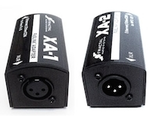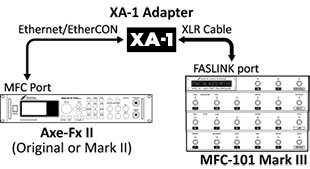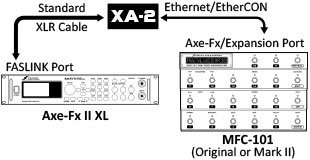This is the wiki for products made by Fractal Audio Systems, maintained by members of the community.
November 2025: the wiki is updated with AM4 data.
Difference between revisions of "FASLINK"
| (179 intermediate revisions by 2 users not shown) | |||
| Line 1: | Line 1: | ||
| − | |||
__TOC__ | __TOC__ | ||
| + | =About FASLINK= | ||
| − | [[ | + | FASLINK is a proprietary Fractal Audio communications protocol. It connects: |
| + | * Axe-Fx II and MFC-101 MIDI foot controller: '''FASLINK''' | ||
| + | * [[Axe-Fx III, FM9, FM3]] and [[FC-6 and FC-12 foot controllers|FC controllers]]: '''FASLINK II''' | ||
| − | + | FASLINK provides two-way communication and power via an XLR microphone cable. Such XLR cables are common, flexible and robust, supporting runs of hundreds of feet. | |
| − | |||
| − | + | The VP4 and AM4 do not support FASLINK. | |
| − | |||
| − | |||
| − | [[ | + | It has replaced previous connection methods for Fractal Audio foot controllers using MIDI and Ethernet. |
| + | |||
| + | There's no need to power down the modeler when connecting the FC controller, <q>hot connecting</q> is supported. | ||
| + | |||
| + | The maximum combined length of multiple cables is [http://forum.fractalaudio.com/threads/faslink-2-cable-length-limit.145778/#post-1723699 100 feet]. | ||
| + | |||
| + | <blockquote> | ||
| + | '''FRACTAL AUDIO QUOTES''' | ||
| + | <HR> | ||
| + | <blockquote> | ||
| + | [http://forum.fractalaudio.com/threads/faslink-2-wiring.144095/#post-1755571] | ||
| + | […] | ||
| + | FASLINK is not a balanced protocol. But it is robust because it uses high signaling levels. You can use any wire for FASLINK but ideally it should be shielded and a heavy enough gauge to carry up to 1A without significant voltage drop. | ||
| + | |||
| + | If "I" were adapting FASLINK to CAT5 I would use each pair as a conductor. I.e. blue and blue/white tied together as one conductor, green and green/white tied together as another conducter. Then the drain wire (and maybe another conductor pair to ensure low resistance) connected to the XLR shield. | ||
| + | |||
| + | FASLINK uses two conductors plus shield (standard mic cable). One conductor is power. The other conductor is data. The shield is the common return for the two conductors. | ||
| + | |||
| + | We've tested FASLINK over 100m of cable. As long as the conductors are heavy enough so the voltage doesn't drop too much you can run it very long distances. | ||
| + | </blockquote> | ||
| + | |||
| + | <blockquote> | ||
| + | [https://forum.fractalaudio.com/threads/so-whats-new-on-the-iii-axe-fx-ii-vs-iii.134729/page-7#post-1592499] | ||
| + | We rewrote everything using a client-server approach. You can have any number of clients attached, even multiple editors, and they all update automatically when something changes (even if changed from the front panel). The foot controllers are essentially clients as well. | ||
| + | </blockquote> | ||
| + | |||
| + | <blockquote> | ||
| + | [https://forum.fractalaudio.com/threads/small-bug-more-an-oversight-regarding-the-tuner.157332/post-1875003] | ||
| + | The FC's are clients. They request data, they do not get data pushed. | ||
| + | </blockquote> | ||
| + | |||
| + | <blockquote> | ||
| + | [http://forum.fractalaudio.com/threads/presenting-the-axe-fx-iii.134717/page-21#post-1593269] | ||
| + | […] | ||
| + | the communication protocol between the III and the FC's is proprietary and not MIDI-based. The FC's are sort of "dumb terminals". All the they do is tell the III "button #3 was pressed" and the III responds by saying "light LED ring #3 blue" or "display 'My Preset' on the main LCD". This way all the configuration data is on the III and when you backup you backup the foot controller as well. It also means if a foot controller fails you don't have to reprogram a new one (which is a big deal for touring acts where the gear gets hammered on and last second change-outs are common). | ||
| + | </blockquote> | ||
| + | |||
| + | <blockquote> | ||
| + | [http://www.thegearpage.net/board/index.php?threads/just-got-my-axe-iii-invite-anyone-try-integrating-it-with-a-helix-as-foot-controller-yet.1952049/page-4#post-26744244] | ||
| + | […] | ||
| + | it's not standard MIDI. The Axe-Fx III uses a proprietary communication protocol. Devices can communicate over any physical layer by wrapping and unwrapping the comm protocol. Theoretically you can control it over MIDI, Ethernet, WiFi, RS-232, AppleTalk, Sneakernet, etc. The MIDI basics are there, of course, but to access the tuner, etc. you need to wrap and unwrap the protocol layer. | ||
| + | </blockquote> | ||
| + | |||
| + | <blockquote> | ||
| + | [https://forum.fractalaudio.com/threads/has-anyone-sniffed-looked-at-the-faslink-ii-protocol.176309/post-2141271] | ||
| + | FASLINK is not MIDI. The FC-6/12 are "terminals". They record button presses and send the button press to the host. The host sends messages to the terminal which tells the terminal what color to display on the LEDs and what text to display on the LCDs. | ||
| + | </blockquote> | ||
| + | |||
| + | <blockquote> | ||
| + | [http://forum.fractalaudio.com/threads/xl-lockup-when-faulty-faslink-xlr-is-connected.105500/#post-1262170] | ||
| + | The FASLINK port is protected against shorts. | ||
| + | </blockquote> | ||
| + | </blockquote> | ||
| + | |||
| + | =Power and daisy-chaining= | ||
| + | |||
| + | You can daisy-chain up to four FC controllers using the FASLINK II <q>THRU</q> ports. | ||
| + | |||
| + | Only the first FC controller gets its power from the Axe-Fx III, FM9 or FM3 through FASLINK II. Additional FC controllers have to be powered separately through their power ports. Use a 9-12V power supply, 1000 ma, negative center, 2.5mm barrel. | ||
| + | |||
| + | Two or more daisy-chained FC units can be forced to remain in sync, showing the same layouts, the same switches and switch states, AKA as <q>mirroring</q>. | ||
| + | |||
| + | <blockquote> | ||
| + | '''FRACTAL AUDIO QUOTES''' | ||
| + | <HR> | ||
| + | |||
| + | <blockquote> | ||
| + | FASLINK powers the first FC. FC setup is same as Axe-Fx III. | ||
| + | </blockquote> | ||
| + | |||
| + | <blockquote> | ||
| + | [https://forum.fractalaudio.com/threads/fas-link-cable-run-works-for-fc-6-but-not-fc-12.154527/post-1838351] | ||
| + | The FC-12 uses more power because it has more LCDs. If the cable resistance is too high then there will be excessive voltage drop which could cause booting issues and other problems. | ||
| + | |||
| + | Using a cable snake is not recommended because the conductor gauge is small and the resistance will be high. We recommend a good quality dedicated XLR cable. Dim LEDs are an indication that there is excessive voltage drop on the cable. | ||
| + | </blockquote> | ||
| + | |||
| + | <blockquote> | ||
| + | [https://forum.fractalaudio.com/threads/fas-link-cable-run-works-for-fc-6-but-not-fc-12.154527/post-1838845] | ||
| + | The FC rated voltage is 9-12V but should work down to about 7V. If the snake is 100 ft. of 24 gauge wire then that would put you right at 7V. The FC-12 draws about 1A so Vdrop = 0.025 ohms/ft * 100 ft * 2 conductors * 1A = 5V drop. This is assuming the shield drain has the same resistance as the conductors. | ||
| + | |||
| + | So, yeah, 100 ft snake is too long for an FC-12. | ||
| + | </blockquote> | ||
| + | |||
| + | <blockquote> | ||
| + | [https://forum.fractalaudio.com/threads/fas-link-cable-run-works-for-fc-6-but-not-fc-12.154527/post-1838562] | ||
| + | Dim LEDs are an indication that there is excessive voltage drop on the cable. | ||
| + | </blockquote> | ||
| + | |||
| + | <blockquote> | ||
| + | [http://forum.fractalaudio.com/threads/timing-on-availability-of-exact-specs-photos-of-fc-6-12.137939/page-4#post-1644453] | ||
| + | They are phantom powered. You can daisy-chain up to four. Any daisy-chained units need their own power supply. IOW only the first unit in the chain is phantom powered. | ||
| + | </blockquote> | ||
| + | </blockquote> | ||
| + | |||
| + | =Issues? It's probably the cable= | ||
| + | |||
| + | If the FC controller won't power on properly, or if the processor shuts down or starts blinking all lights, it's almost certainly caused by the cable. Use another standard microphone cable instead. | ||
| + | |||
| + | =FASLINK adapters for legacy hardware= | ||
| + | |||
| + | The FASLINK XA-1 and XA-2 adapters convert the wiring on the Axe-Fx II Mark I and II, and the MFC-101 Mark I and II, from Ethernet/Ethercon to XLR. These adapters are <q>active</q>. The adapters do not support FASLINK II! Read the [[Owners_Manuals|FASLINK Setup Guide]] for more information. | ||
| − | + | Do NOT connect a power supply to the MFC-101 when using FASLINK. | |
[[file:FASLINK_adapters.png|150px|link=]] | [[file:FASLINK_adapters.png|150px|link=]] | ||
| − | + | [[file:XA-1 diagram.png]] | |
| − | |||
| − | |||
| − | + | [[file:XA-2 diagram.png]] | |
| − | |||
| − | |||
| − | |||
| − | |||
| − | [[category:Axe- | + | [[category:Axe-Fx2]] |
| − | [[category: | + | [[category:Axe-Fx3]] |
| − | [[category: | + | [[category:FM3]] |
| + | [[category:FM9]] | ||
| + | [[category:All]] | ||
Latest revision as of 23:44, 1 December 2025
Contents
About FASLINK
FASLINK is a proprietary Fractal Audio communications protocol. It connects:
- Axe-Fx II and MFC-101 MIDI foot controller: FASLINK
- Axe-Fx III, FM9, FM3 and FC controllers: FASLINK II
FASLINK provides two-way communication and power via an XLR microphone cable. Such XLR cables are common, flexible and robust, supporting runs of hundreds of feet.
The VP4 and AM4 do not support FASLINK.
It has replaced previous connection methods for Fractal Audio foot controllers using MIDI and Ethernet.
There's no need to power down the modeler when connecting the FC controller, hot connecting
is supported.
The maximum combined length of multiple cables is 100 feet.
FRACTAL AUDIO QUOTES
[1] […] FASLINK is not a balanced protocol. But it is robust because it uses high signaling levels. You can use any wire for FASLINK but ideally it should be shielded and a heavy enough gauge to carry up to 1A without significant voltage drop.
If "I" were adapting FASLINK to CAT5 I would use each pair as a conductor. I.e. blue and blue/white tied together as one conductor, green and green/white tied together as another conducter. Then the drain wire (and maybe another conductor pair to ensure low resistance) connected to the XLR shield.
FASLINK uses two conductors plus shield (standard mic cable). One conductor is power. The other conductor is data. The shield is the common return for the two conductors.
We've tested FASLINK over 100m of cable. As long as the conductors are heavy enough so the voltage doesn't drop too much you can run it very long distances.
[2] We rewrote everything using a client-server approach. You can have any number of clients attached, even multiple editors, and they all update automatically when something changes (even if changed from the front panel). The foot controllers are essentially clients as well.
[3] The FC's are clients. They request data, they do not get data pushed.
[4] […] the communication protocol between the III and the FC's is proprietary and not MIDI-based. The FC's are sort of "dumb terminals". All the they do is tell the III "button #3 was pressed" and the III responds by saying "light LED ring #3 blue" or "display 'My Preset' on the main LCD". This way all the configuration data is on the III and when you backup you backup the foot controller as well. It also means if a foot controller fails you don't have to reprogram a new one (which is a big deal for touring acts where the gear gets hammered on and last second change-outs are common).
[5] […] it's not standard MIDI. The Axe-Fx III uses a proprietary communication protocol. Devices can communicate over any physical layer by wrapping and unwrapping the comm protocol. Theoretically you can control it over MIDI, Ethernet, WiFi, RS-232, AppleTalk, Sneakernet, etc. The MIDI basics are there, of course, but to access the tuner, etc. you need to wrap and unwrap the protocol layer.
[6] FASLINK is not MIDI. The FC-6/12 are "terminals". They record button presses and send the button press to the host. The host sends messages to the terminal which tells the terminal what color to display on the LEDs and what text to display on the LCDs.
[7] The FASLINK port is protected against shorts.
Power and daisy-chaining
You can daisy-chain up to four FC controllers using the FASLINK II THRU
ports.
Only the first FC controller gets its power from the Axe-Fx III, FM9 or FM3 through FASLINK II. Additional FC controllers have to be powered separately through their power ports. Use a 9-12V power supply, 1000 ma, negative center, 2.5mm barrel.
Two or more daisy-chained FC units can be forced to remain in sync, showing the same layouts, the same switches and switch states, AKA as mirroring
.
FRACTAL AUDIO QUOTES
FASLINK powers the first FC. FC setup is same as Axe-Fx III.
[8] The FC-12 uses more power because it has more LCDs. If the cable resistance is too high then there will be excessive voltage drop which could cause booting issues and other problems.
Using a cable snake is not recommended because the conductor gauge is small and the resistance will be high. We recommend a good quality dedicated XLR cable. Dim LEDs are an indication that there is excessive voltage drop on the cable.
[9] The FC rated voltage is 9-12V but should work down to about 7V. If the snake is 100 ft. of 24 gauge wire then that would put you right at 7V. The FC-12 draws about 1A so Vdrop = 0.025 ohms/ft * 100 ft * 2 conductors * 1A = 5V drop. This is assuming the shield drain has the same resistance as the conductors.
So, yeah, 100 ft snake is too long for an FC-12.
[10] Dim LEDs are an indication that there is excessive voltage drop on the cable.
[11] They are phantom powered. You can daisy-chain up to four. Any daisy-chained units need their own power supply. IOW only the first unit in the chain is phantom powered.
Issues? It's probably the cable
If the FC controller won't power on properly, or if the processor shuts down or starts blinking all lights, it's almost certainly caused by the cable. Use another standard microphone cable instead.
FASLINK adapters for legacy hardware
The FASLINK XA-1 and XA-2 adapters convert the wiring on the Axe-Fx II Mark I and II, and the MFC-101 Mark I and II, from Ethernet/Ethercon to XLR. These adapters are active
. The adapters do not support FASLINK II! Read the FASLINK Setup Guide for more information.
Do NOT connect a power supply to the MFC-101 when using FASLINK.


